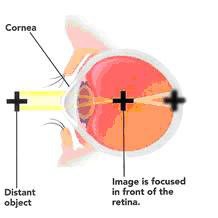|
REFRACTIVE ERRORS
The normal eye - Myopia - Hyperopia - Astigmatism - Presbyopia

The normal eye
When your eyes are normal, you can see things
nice and clear. They are not blurred or distorted.
The cornea and lens help to converge rays of light
to focus onto the retina.
When that happens you have a good signal to the
brain so we can see the object clearly. When we
read, the muscles change the shape of the lens
(= accommodation), the image is focused on the retina.
|
 Myopia or near-sightedness Myopia or near-sightedness
When this occurs, you can see objects clearly nearby but objects in the distance are blurry.
The image is focused in front of the retina.
The cornea and/or lens are too curved, or the distance between the cornea and the retina is too long, the eyeball is too long.

|
Hyper(metr)opia or far-sightedness 
When this occurs, you can see objects clearly from a distance but objects nearby are blurry.
In the beginning this is experienced as an exhausting, pressured feeling with close work.
If you have a stronger hyperopia, it can be possible that objects from a greater distance are also blurry.
The rays of light from a nearby object are now focused behind the retina. The cause of this can be that either the retina or the cornea are too close to each other.
Your eye is too short, or the retina and/or lens are too flat So that the light rays branch off.

|
 Astigmatism Astigmatism
When your cornea is not round, you can compare it to a
rugbyball. In this case you have astigmatism. You see the objects nearby and at a distance, you see them blurred.
Astigmatism often occurs combined with myopia or hyperopia.
Because the cornea surface isn’t round, the image is not focused on one but on two or more places in front of or behind the retina.
|
Presbyopia 
Little children have no problem focussing their eyes on
objects nearby. They can see little things very clearly at
close range. This capability to “zoom in” at close (accommodation) decreases slowly without any notice during the years, after the age of 40-45, it becomes more difficult to thread a needle and later on also to work on a computer. This process of decline stops approximately at 60-65 years of age. The capability to focus on nearby objects (reading distance), accommodation, declines.
The cause of this is that the lens becomes harder during
the years and less flexible, so the lens can not adjust anymore for objects nearby. |
|

